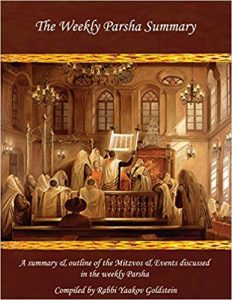*The article below is an excerpt from the above Sefer
*As an Amazon Associate I earn from qualifying purchases.
Parshas Beshalach
Pesukim: 116 [Siman: יד אמונה]
Haftorah: Shoftim 4:4[1]-5:31
Number of Mitzvos: There is a total of One Mitzvah in Parshas Beshalach. Zero positive command and One negative commands.
Negative commands: 1. Mitzvah 24/Negative 13: Not to leave the Techum/border on Shabbos.[2] |
Rishon
- Bnei Yisrael journey after leaving Egypt:
- The route: After Pharaoh sent the nation, Hashem, rather than taking them through the land of the Philistines which was a shorter route, he took them the roundabout route through the desert of the Sea of Reeds. This is because Hashem feared perhaps the people would turn back if taken by the short route.
- Arms: The Jewish people were armed when they left Egypt.
- Yosef’s bones: Moshe took with him Yosef’s bones out of Egypt, as Yosef made the Jewish people swear to take them when they left.
- Journeying to Eisam: They traveled from Sukkos to Eisam, which was at the end of the desert.
- The clouds of glory: Hashem went before the Jewish people in a pillar of cloud in order to guide them. At night He went before them in a pillar of fire, to shine for them the night, so they could travel by day and by night.
- Turning back to Pi Hachiros: Hashem instructed Moshe to turn back and encamp by Pi Hachiros which is between Migdal and the sea, opposite Baal Tzefon. “Pharaoh will then exclaim regarding Bnei Yisrael that they have trapped themselves in the desert and I will harden his heart so he gives chase, and then Egypt will know that I am Hashem.”
- The Jewish people did as they were instructed.
- Pharaoh chases after Bnei Yisrael:
- Pharaoh was told that the Jewish people had fled, and he and his servants regretted having sent them out. He thus harnessed his chariot and took his people with him. He took six hundred select chariots, together with all of Egypt’s chariots to chase after the Jewish people.
- Hashem hardened the heart of Pharaoh to chase after the Bnei Yisrael and meanwhile the Jewish people were going out with a raised hand.
[1] So is followed by Ashkenazi and Chabad communities. However, Sefaradi communities begin reading from 5:1
[2] Listed by Rambam, Chinuch, however is not considered a Biblical prohibition according to Ramban. See Chinuch ibid; Admur 396:1 for both opinions.
Related Articles
Daily Chumash & Rashi – Parshas Vayechi Rishon: Yaakov meets with Yosef and his sons before his death (Sunday, 8th Teves)
Post Views: 1,118 *The article below is an excerpt from the above Sefer *As an Amazon Associate I earn from qualifying purchases. Donate Buy in Paperback or Kindle Buy on Apple Books Purchase on our website Sign up for Daily Distribution Sponsor an Episode Parshas Vayechi Pesukim: 85 [Siman: פה
Daily Chumash & Rashi – Parshas Vayigash Chamishi: Yaakovs family who arrived to Mitzrayim (Thursday, 5th Teves)
Post Views: 1,278 *The article below is an excerpt from the above Sefer *As an Amazon Associate I earn from qualifying purchases. Donate Buy in Paperback or Kindle Buy on Apple Books Purchase on our website Sign up for Daily Distribution Sponsor an Episode Chamishi (according to Torah Temima/Chabad) Yaakovs
Daily Chumash & Rashi – Parshas Vayigash Revi’i: Yaakov and family travel to Mitzrayim (Wednesday, 4th Teves)
Post Views: 994 *The article below is an excerpt from the above Sefer *As an Amazon Associate I earn from qualifying purchases. Donate Buy in Paperback or Kindle Buy on Apple Books Purchase on our website Sign up for Daily Distribution Sponsor an Episode Revi’i (according to Torah Temima/Chabad) Chamishi
Daily Chumash & Rashi – Parshas Vayigash Shelishi: Yosef instructs his brothers and asks them to bring their father to Mitzrayim (Tuesday, 3rd Teves)
Post Views: 1,054 *The article below is an excerpt from the above Sefer *As an Amazon Associate I earn from qualifying purchases. Donate Buy in Paperback or Kindle Buy on Apple Books Purchase on our website Sign up for Daily Distribution Sponsor an Episode Shelishi “It is not you who
Daily Chumash & Rashi – Parshas Vayigash Sheiyni: Yosef reveals himself to the brothers (Monday, 2nd Teves)
Post Views: 1,284 *The article below is an excerpt from the above Sefer *As an Amazon Associate I earn from qualifying purchases. Donate Buy in Paperback or Kindle Buy on Apple Books Purchase on our website Sign up for Daily Distribution Sponsor an Episode Sheiyni When Yaakov will see that
Daily Chumash & Rashi – Parshas Vayigash Rishon: Yehuda contends with Yosef to release Binyamin (Sunday, 1st Teves)
Post Views: 1,011 *The article below is an excerpt from the above Sefer *As an Amazon Associate I earn from qualifying purchases. Donate Buy in Paperback or Kindle Buy on Apple Books Purchase on our website Sign up for Daily Distribution Sponsor an Episode Parshas Vayigash Pesukim: 106 [Siman: יהללאל]


 Donate
Donate
Leave A Comment?
You must be logged in to post a comment.